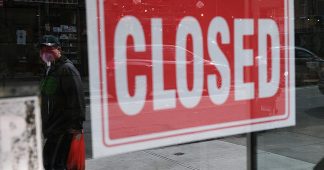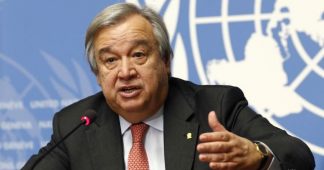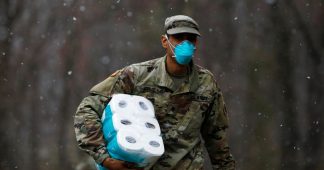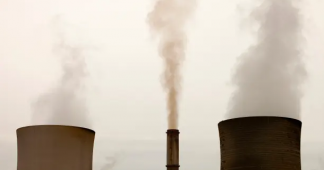The second in a seven-part, multi-week series of commentary on the COVID-19 crisis
By Radhika Desai
May 14, 2020
This is the second in a seven-part, multi-week series of commentary on the COVID-19 crisis entitled WHAT IS TO BE DONE? A MANIFESTO FOR POLITICS AMID THE PANDEMIC AND BEYOND by Radhika Desai, Professor of Political Studies and Director of the Geopolitical Economy Research Group at the University of Manitoba.
The present crisis mixes public health, economic and political crises. Each consists of the pandemic bringing decades-long processes of decay and decomposition to a head. As more and more governments move to relax lockdown restrictions while curves of infections and deaths flatten (and some, like Russia, do so despite little evidence of such flattening), rather than letting up, each of these crises is intensifying.
Successful countries like Germany and Singapore eased their lockdowns after early victories in reducing infections only to find infection rates rising again. While they are likely to contain the new outbreaks with their already proven methods, the chaos caused by the easing of lockdowns in the core neoliberal countries implies that a new surge is practically inevitable. This means that further lockdowns are equally likely, testing the resilience of already weakened economies further. Moreover, even where easing can continue, it is not clear how much of economic activity will revive.
Knowledge of the virus, its effects and the possibility of immunity through vaccines is still developing. Confusion, uncertainty, disinformation and fear reign as governments appear to economise on the truth of the pandemic and the rationales of their response and popular distrust of corporate control of science gives rise to a new generation of conspiracy theories. Amid all this, workers and customers will likely demand protections that both governments and businesses are ill-equipped to provide.
All this can only heighten the political crisis, the subject of several installments to follow. Suffice it to note here that new political divides are emerging as the brief popularity of incumbent governments, which skyrocketed in the initial weeks after the March lockdowns, plummet amid new controversies over whether, when and how easing should be implemented and the dangers of working in the pandemic context are extended beyond ‘essential workers’.
While viral epidemics have occurred with increasing regularity, particularly in the neoliberal era since at least the AIDS crisis, and while there has been a distinct acceleration with the SARS, MERS, Ebola and Zika, these viruses were less contagious and (so far) more easily contained. The far more virulent novel coronavirus that causes COVID-19 has turned into what the WHO has deemed a pandemic. It could result in staggering numbers of dead if not controlled. Neoliberal governments, on the one hand, have attempted to control the spread of the virus through lockdowns of varying degrees of severity, causing unprecedented economic stoppage only to avoid unmanageable political crises. On the other hand, these governments are in most cases fundamentally ill-equipped to deal with it, prolonging the economic crisis.
Pandemics and Social Contracts
The Spanish Flu pandemic, which could have killed as many as 100 million worldwide, did not present the same choices. Viruses were incompletely understood in 1918 and that limited governments’ responsibility. Today we know an enormous amount about viruses, their treatment and even their eradication. The world succeeded in eradicating at least one major virus that had historically caused untold misery: the last small pox case occurred in 1977 and in 1980, the WHO declared it completely eradicated. In 1918, governments did little more than warn, and even that was impeded by the war (the warring sides found it convenient to claim that the epidemic was mainly in neutral Spain when it was, in fact, devastating troops and civilians across Europe). The situation today is starkly different.
In the twenty-first century, we expect our governments, even the most right wing and the most zealously committed to capitalist interests, to protect us from such epidemics or pandemics.
The Spanish Flu occurred at the start of the Thirty Years’ Crisis of 1914-45, which transformed the world. The world that entered it was authoritarian and imperial. Its tortuous course, which included two World Wars, fascism and the Great Depression, transformed that world into one of far greater popular power as populations were mobilised for war, revolutions and national liberation.
Liberal democratic Keynesian welfare states emerged in the imperial homelands of capitalism. Communist revolutions in ‘backward’ Russia and semi-colonised, invaded and civil-war-torn China bookended the Thirty Years’ Crisis, while also prevailing in the countries of Eastern Europe liberated by the Red Army. Meanwhile in the colonial or semi-colonial world, decolonization and the ebbing of imperial power led to the emergence of developmental regimes committed to overcoming the legacy of colonial and semi-colonial control by building productive and egalitarian economies and societies. It is not surprising that small pox was eradicated while the world was under the watch of such regimes.
This era of popular empowerment ended in a crisis that brought the world to a momentous fork in the road: more popular empowerment through further reforms of capitalism or a roll back of the reforms–the commitment to full employment, strong unions, welfare states and public services, unemployment, sickness, pension, child and other benefits—of the era of popular empowerment. The choice of the latter was fateful in many ways and it is no wonder that no other virus has been eradicated in the neoliberal era that began about 1980.
The social contracts of the post-war era, in which governments took responsibility in nearly all sectors of social life, including material welfare, cultural advancement, relative equality and public health, was not in place when humanity confronted the Spanish Flu. Today, though neoliberal policies have whittled away at it for four decades, that contract is down but is not out. Neoliberals would have dearly loved to repudiate the contract outright. However, thanks to popular attachment to the gains of the previous era, it was forced to advance more surreptitiously, undermining its material foundation, while claiming to achieve its goals more effectively. Its manifest and myriad failures to achieve them have left many hostages to political fortune.
Chief among them has been the still-strong belief that public health is a government responsibility. Neoliberal governments must now fulfill this expectation with public health infrastructures debilitated by four decades of neoliberal policies aimed at increasing risk-free corporate profits by permitting private corporate interests to prey upon vast public health sectors through underfunding, privatization, contracting out, increasing payment for drugs, equipment and services, low pay for health care workers and so on. When COVID-19 arrived on Western shores, pandemic preparedness was , despite many warnings about imminent pandemic outbreaks, more or less non-existent in the neoliberal world. Stocks of necessary medical equipment, drugs and safety gear were woefully inadequate to the challenge. Indeed, some countries, such as the United States, had reversed what steps previous administrations had taken.
The Neoliberal Choice: Herd Immunity or Herd Immunity?
Unless neoliberal governments act to contain the pandemic, or if they are successful in implementing ‘herd immunity’ strategies, the pandemic could require hospitalising about seven percent of the global population and result in fatalities at a rate of 0.35 to 0.7 percent. Near or at its peak, such a freely developing pandemic would overwhelm health systems shrunk and weakened by decades of austerity. Economies would be devastated by ill or self-quarantining workers, lost skills, broken teams and supply chains, collapsed demand and rising debt. Already creaking political structures would be brought down by the widespread failure of states to ensure basic security of life, not to mention the inevitable train of lies and cover-ups by politically insecure governments that will further undermine trust in the rapidly deteriorating scene. Political disintegration or authoritarianism will be the stark options, at least in the absence of empowered political communities taking charge. That last eventuality would, of course, spell the beginning of the end of capitalism.
Neoliberal governments are anxious to avoid this scenario, but have been unable to muster the public health resources to tackle the pandemic head-on. They are afraid that its uncontrolled outbreak will overwhelm the weakened public health infrastructure, but are unable to supplement it in short order and equip it with the resources to root out the virus through testing, tracking, isolating and treating, as China did in Wuhan, at the site of other much smaller outbreaks in the rest of the country. The only alternative is to slow the spread of the pandemic with lockdowns that bring their economies to a standstill. As the Independent Sage, a group of UK scientists, have pointed out, without a strategy to root out the virus before it infects and endangers sizeable proportions of the population, “a more rapid return of local epidemics resulting in more deaths and potentially further partial or national lockdowns, with the economic costs that will incur” is inevitable. Indeed, the difference between strategies adopted by neoliberal governments and the fatal strategy of ‘herd immunity’ is often hard to tell.
Indeed, official statistics probably underestimate fatalities substantially. Estimates of both infections and deaths due to the virus are artificially low since testing levels have been so inadequate. Given this, the best estimates of COVID-19 fatalities can be found in statistics of excess deaths, the positive difference between deaths in corresponding periods in the previous year or years and those in the current year. In the UK, for instance, the official tally of deaths due to COVID-19 was 32,065 but the excess deaths as reported by the Office for National Statistics for the relevant period were 50,979, over 60 percent higher.
Capitalism’s Crisis
Therefore, most fundamentally, we must understand this crisis as a crisis of capitalism. It is so in at least three senses. Firstly, as is increasingly widely appreciated, recent epidemics are themselves internal to capitalism, related to its rapacious exploitation of nature. The resulting extreme loss of habitat for wildlife brings it closer to human habitation and activities and, when they intersect with the concentration of domesticated animals in factory farms, they increase the possibilities of viruses, normally confined to animal populations immune to them, jumping to other species including humans. In addition to the horrors SARS, MERS, Ebola and Zika hold for humans, the zoonotic epidemics of recent times have included outbreaks on farms that have resulted in the mass culling of millions of animals.
Secondly, the economic crisis precipitated by the combination of government responsibility for public health and their incapacity constitutes, as I argued in March, only the acceleration of a long overdue reckoning of the accumulated contradictions of neoliberal capitalism that had already discredited entire political establishments. It feeds off its productive part and the incomes of the vast majority of the people to swell the wealth and power of a tiny unproductive financial elite. It cannot do so for long without approaching entropy.
Finally and most crucially, this pandemic is a crisis of capitalism because the entirely endogenous pandemic has brought neoliberal capitalism as a form of social production to the point where it has no other way of keeping its workers alive than shutting itself down. Worse, it cannot open back up without risking new outbreaks. It reminds one of what Marx and Engels pointed out in their Communist Manifesto. “In order to oppress a class”, they wrote, “certain conditions must be assured to it under which it can, at least, continue its slavish existence”. They go on to say:
… the bourgeoisie is unfit any longer to be the ruling class in society, and to impose its conditions of existence upon society as an over-riding law … because it is incompetent to assure an existence to its slave within his slavery, because it cannot help letting him sink into such a state, that it has to feed him, instead of being fed by him.
This was, of course, the famous ‘immiseration’ thesis. Many point to the relative prosperity of Western working classes in refutation, though it is far less convincing if we take in the working people of the world as a whole. In any case, today it resonates because capitalism has proved itself incapable of ensuring the existence of its working population against a threat produced by itself without shutting itself down. It is in this sense that the pandemic is a crisis of capitalism itself.
This form of organising society and social production is no longer sustainable or even possible. Moreover, humanity has already witnessed a more than century-long history of attempting alternatives to capitalism. This necessity can only become more urgent as the preservation of the system becomes more reliant on increasing authoritarianism.
How Did It Come to ‘Lives versus Livelihoods’?
When the gravity of the situation hit the West in the second week of March, after the World Health Organization proclaimed the pandemic, neoliberal governments responded, as they have for decades, with monetary policy in spades, cutting interest rates to near zero and announcing asset purchase programmes on an unprecedented scale. It soon became clear, however, that this crisis was different, not originating in financial markets and whiplashing the economy but vice versa, and leading to gyrations in the stock market far more serious than any ever witnessed. The stock market has since recovered, thanks to the massive injection of liquidity from central banks, led by the US Federal Reserve. However, given the debility of the productive economy on which it must ultimately depend, this recovery is not expected to last.
Once they realised the scale of the threat and had to impose severe forms of social distancing, requiring near total economic shutdown, neoliberal governments were also forced, in another unprecedented move, to announce massive income support programmes. However, as we shall see, this response, which has aroused much political hope, has neoliberalism’s paw prints all over it. Not only has it been turned into an exercise to further benefit finance by providing it as credit, rather than income, and adding to the already unsustainable debt burden of the world, it is iniquitous, authoritarian, and heavily biased in favour of capital, particularly finance.
Thanks to the ineffectiveness of this public health response, the decline in economic activity threatens not to be short-lived, as many expected only weeks ago. This makes the choice between ‘lives’ and ‘livelihoods’ (what is one to say about a system that generates that choice?) more pressing. Political tussles have already broken out within the neoliberal camp over lifting the controls to get the economy going again, complete with capitalists funding protests against lockdowns, and this can only make their public health response more incoherent and make any second wave of infections more likely and worse, lengthening the economic crisis. The longer it persists, the farther the possibility of any ‘return’ to a pre-pandemic normal recedes and the closer we come to an economic catastrophe far exceeding the Great Depression.
How Not to Organise Societies
Indeed, the truly effective suppression strategy requires something that, as the Independent Sage report revealed, neoliberalism lacks, and has spent the last many decades destroying—community and trust. The effective suppression of the virus involves altering human behaviour and that requires not so much the high-cost medicine provided by the medical-industrial complex as a lower cost approach that mobilises communities. One of the 18 recommendations of the Independent Sage report was this:
Communities and civil society organisations should have a voice, be informed, engaged and participatory in the exit from lockdown. This pandemic starts and ends within communities. Full participation and engagement of those communities on issues such as childcare and public transport will assist with enabling control measures. Conversely, a top-down approach risks losing their support and trust.
The effectiveness of this approach was already clear in China and some other Third World jurisdictions and are also emerging as bright spots, particularly the Indian state of Kerala and Vietnam. Elsewhere in the Third World, by contrast, the lockdowns have been even more chaotic, ineffective and punishing to ordinary working people than those in the West. Amid authoritarian lockdowns and police brutality against working people the stigmatization of and victimization of minorities is rife even as cases continue to climb. In these circumstances, while the pandemic has been late in arriving in countries outside East Asia and the West, the number of cases in most of them is still climbing steeply.
For decades, neoliberal policies have resulted in creating a corporate medical industrial complex that prioritises lucrative drugs and vaccines rather than cures and people-centered prevention: “There’s gold in them thar pills”, as an early, witty critic put it. The increasingly common occurrence of zoonotic viruses led, for instance, to vast and lucrative research projects, such as the Global Virome Project. It seeks to map the entire world of viruses, most of which will never reach humans, rather than focusing on the people working along the ‘faultlines’ where the few leaps to humans that prove so fatal are likely to happen. The latter approach is based on the understanding that “Humans are the best sentinels: A virus discovered in humans very obviously can replicate in that host, which will not be the case for myriad viruses identified through biodiversity surveys of other [animals].” It is, however, far less lucrative for corporations and their allies in universities. Needless to say, since the COVID-19 outbreak, dozens of Big Pharma corporations and research institutions have joined the race for the vaccine, amply funded by public money, even as it is being reported that immunity to the novel coronavirus fades quickly, making a vaccine nearly impossible.
There is worse. Neoliberal societies have performed less well even in high-technology elements of a suppression strategy, as in the use of smartphones for contact tracing. Their successful use in China, Taiwan and South Korea is decried as authoritarian and an invasion of privacy. The irony is, of course, that the privacy of Western citizens has long been surrendered to internet companies who glean the most intimate information about them from ‘big data’ to sell their eyeballs to advertisers. Ever more important in a world where firms must reduce uncertainty of demand by creating it through more and more finely targeted advertising, such practices have trapped Western citizens in the so-called privacy paradox: “Whenever researchers, opinion pollsters and other busybodies ask people if they value their privacy, they invariably respond with a resounding ‘yes’. The paradox arises from the fact that they nevertheless continue to use the services [such as Facebook and Google] that undermine their beloved privacy.”
Worse still, these internet companies are also colluding with the US military industrial complex in aiding its surveillance objectives. While their privacy is assured neither against the state nor against big capital, Western citizens must wait for effective contact tracing while these internet companies compete to come up with apps they can sell for huge profits to governments.
Neoliberalism in the Third World
So far, the spread of the novel coronavirus in the neoliberal Third World remains limited, at least as far as official statistics are concerned. However, they may be very wide of the mark and it may be a matter of time before the virus spreads there. The Spanish Flu, for instance, killed between 12-17 million in India alone, around five percent of its population then, while Iran was completely decimated, that is to say, it lost about one tenth of its population (and possibly double that).
The combination of the relative lack of resources, creaking public health infrastructures, the economic insecurity of large proportions of the global population, high levels of inequality, and authoritarian states and social structures, will constitute a toxic cocktail of political challenges even greater than any in the Western world. As UNCTAD has warned, this is happening when the resources for recovery in the form of replacement demand or sources of capital have been further depleted, commodity prices are very low and most Third World countries have run down their reserves and have high levels of indebtedness. Indeed, torrents of money are flowing out of Third World countries just when they need it most as the long-standing destructive pro-cyclicality of the international monetary and financial system reveals itself with a vengeance. While this outflow has been partially reversed after the Federal Reserve and other central banks opened the spigots of liquidity, the new lending is only a relatively safe investment opportunity for the Western financial system currently starved of other equally lucrative ones.
Though many Third World countries have imposed lockdowns of varying degrees of severity, the desire to prevent the spread of COVID-19 has—even more clearly than in the neoliberal metropoles—been mixed up with incompetence, a malign neglect of the interests of the people, and authoritarianism, both of governments and state structures down to the lowest levels of enforcement agencies. In this context, given the material precarity of most of the population, and lack of income support and food security measures (as much due to lack of resources as political unwillingness) such lockdowns are also endangering lives through hunger and the increased morbidity that it will bring. The means to address this are, meanwhile, ignored by neoliberal governments.
If such cocktails of public health, economic and political crises do bring down the governments of a Bolsanaro, a Modi or a Duterte, few sensible people will shed tears. The real question is whether, politically more responsible forces will be able to take over. The situation varies from country to country. At least in Brazil, the Workers’ Party (Partido dos Trabalhadores, PT) retains some credibility but in India, the situation is considerably worse. Though some state governments have demonstrated sensitivity to the needs of workers and farmers, both Congress and the left have shrunk to shadows of their former selves.
Whether in the Third World or the First, the pandemic has upended neoliberal economic orders. Whether they will be reconstituted by the left or the right is what is at stake in the political struggles that ensue. In the next two installments, we asses the limitations and resources of the contending forces.
Radhika Desai is a professor in the Department of Political Studies at the University of Manitoba and currently serves as the director of the Geopolitical Economy Research Group.











